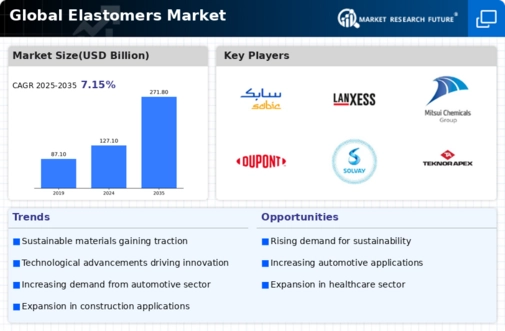Market Analysis
In-depth Analysis of Elastomers Market Industry Landscape
The elastomers sector (EMI) has witnessed rapid developments over recent years driven by multipurpose industries looking for high performance and durable materials which can be applied in a diverse range of applications. The term elastomers, which is a representation of the word rubber, is a subset of polymers that has the unusual properties of being elastic and flexible. They aid engineering applications in many industries such as the automotive, construction, health care, consumer industries, and many more. One of the important market dynamics that drive the demand in the automotive sector is the growing demand for rubber in which tires, seals, gaskets and other components are manufactured extensively. The automotive industry’s desirable properties for lightweight materials, more efficient fuel usage, and higher safety standards play a crucial part in bringing the elastomers’ usage to sustainability.
Construction too, as a critical sector, figures in a number of ways that elastomers are used in construction joints, adhesives, membranes and other components. The flexibility of elastomers to endure changing weather conditions, providing shelter to people and durability of buildings while minimizing the danger to human injuries is the very reason why they are required in construction. With increasing international expansion of the construction industry, market demand responds by looking for long lasting and able to survive materials in products and these specifications are met by the fabrication of rubber materials.
Healthcare industry, which represents the pivotal driving force in the elastomers market, also affects the market dynamics. Medical devices, surgical instruments and pharmaceuticals packing can be produced by elastomers due to their stability, flexibility and ability to be sterilized. The prompt growth of the healthcare sector with the emerging technical innovations in the medical technology make elastomeric materials more sought-after, giving the industry players a chance to enrich their offers.
The elastomers market dynamic is also influenced by the consumer goods industry where there are hundreds of manufacturers and elastomers are extensively used in the making of footwear, clothing, houseware, sports and other goods. The range of properties of elastomers that it offers to manufacturers assists them to meet specific requirements of their clientele through the use of products that can be soft as well as durable at the same time, resistant to abrasion. With regard to consumer aesthetics, as well as long term sustainability, they largely choose products of intelligent design which utilize elastomers.
Nevertheless, the world of elastomers is not without problems: such problems include: the difficulty of buying raw material, the consideration of the environment in disposal and recycling, as well as the need for special formulations to meet the luxury industry requirements. The whole industry is attempting to overcome these challenges by investing in the research and development of sustainable and environmentally friendly elastomers and by exploring the recycling technology as well as advance formulations which can be used to enhance performance and meet specific purposes.









Leave a Comment